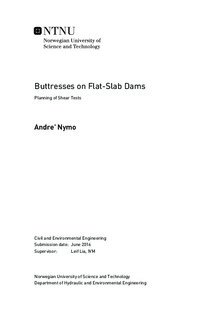Buttresses on Flat-Slab Dams - Planning of Shear Tests
Master thesis
Permanent lenke
http://hdl.handle.net/11250/2433629Utgivelsesdato
2016Metadata
Vis full innførselSamlinger
Sammendrag
The shear strength of a bonded concrete-rock interface below a concrete dam consists of two parts: friction from the self-weight of the dam and cohesion due to the glue in the cement paste binding the surfaces together. For flat-slab buttress dams with low self-weight, the cohesive strength becomes extra significant for the sliding resistance. However, the Norwegian authorities on dam safety does not allow the use of cohesion in sliding stability calculations, unless the cohesive strength can be documented through tests. Yet, no proposal is given on how such tests should be carried out.
Consequently, the main scope of this thesis have been to develop and propose a test methodology to estimate the cohesive strength of Norwegian flat-slab buttress dams. The proposed testing procedure uses rock samples from the dam site to get the occurring roughness and strength of the bedrock. Furthermore, the test-specimen are prepared and concrete replicating the concrete of the dam are then cast on the natural surfaces of the rock samples. A series of shear tests is then carried out to measure the shear strength of the concrete-rock interfaces. Finally, the value of the cohesion is extrapolated out of the τ-σ curve. Preliminary testing of the methodology revealed the importance of thorough preparation of the test-specimen beforehand, but in the end left the author optimistic regarding the test methodology s future use.
Additionally, to investigate the effect of including cohesion in sliding stability calculations, the sliding safety of one of Statkrafts flat-slab buttress dams, Kalhovd dam, was assessed with a combination of FE-analysis and simplified hand calculations. The results showed that by assuming reasonable values for the cohesion, the dam managed to meet the requirements from the Norwegian dam authorities. One problem when applying cohesion in calculations, however, is to determine the compressive zone of the dam. Assuming a linearly distributed normal stress seemed to overestimate the compressive area compared to the results from the finite element analysis, indicating that the latter might be the best tool for this purpose.
